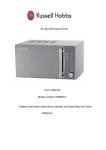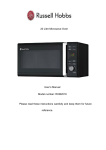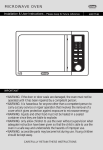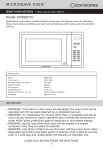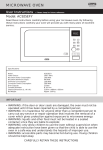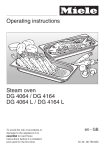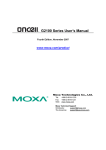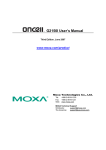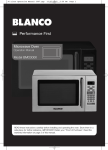Download MICROWAVE OVEN
Transcript
MICROWAVE OVEN User Instructions - Please keep for future reference Model: SEB177G3H-P Read these instructions carefully before using your microwave oven. By following these instructions carefully your oven will provide you with many years of excellent service. Specifications Model: Power Source: Microwave Power Consumption: Microwave Maximum Output: Oven Capacity: Turntable Diameter: External Dimensions (L x W x H): Net Weight: SEB177G3H-P 230V~240V/50Hz 1200 Watt 700 Wattt 17 litres Ø 245 mm 262X452X357mm Approx. 10.50Kg IMPORTANT • WARNING: if the door or door seals are damaged, the oven must not be operated until it has been repaired by a competent person。 • WARNING: it is hazardous for anyone other than a competent person to carry out any service or repair operation that involves the removal of a cover which gives protection against exposure to microwave energy; • WARNING: liquids and other food must not be heated in a sealed container since they are liable to explode; • WARNING: only allow children to use the oven without supervision when adequate instruction have been given so that the child is able to use the oven in a safe way and understands the hazards of improper use. • WARNING: accessible parts may become hot during use. Young children should be kept away. CAREFULLY RETAIN THESE INSTRUCTIONS SAFETY INSTRUCTIONS 1. The oven must be placed on a level surface. 2. The turntable and turntable ring assembly must always be used in the oven during cooking. Place the cookware gently on the turntable and handle it carefully to avoid possible breakage. 3. Incorrect use of dish for browning food may cause turntable to break. 4. Use only the specified bag size when using pre-prepared popcorn. 5. The oven has several built-in safety switches to ensure that the power remains off when the door is open. Do not tamper with these switches. 6. Do not operate the microwave oven when empty. Operating the oven with no food or food that is extremely low in moisture can cause fire, charring or sparking. 7. Do not cook bacon directly on the turntable. Excessive local heating of the turntable may cause the turntable to break. 8. Do not heat baby bottles or baby food in the microwave oven. Uneven heating may occur which could cause scalding when feeding the baby. 9. Do not heat narrow-necked containers, such as syrup or sauce bottles. 10. Do not attempt to deep-fry in your microwave oven. 11. Do not attempt home canning in this microwave oven as it is impossible to be sure all contents of the jar have reached boiling temperature. 12. Do not use this microwave oven for commercial purpose. This microwave oven is made for household use only. 13. To prevent delayed eruptive boiling of hot liquids and beverages or scalding yourself, stir liquid before placing the container in the oven and during heating. 14. Check the food in the microwave oven frequently to avoid burning due to overheating. 15. Failures to maintain the oven in a clean condition could lead to deterioration of the surface which could adversely affect the life of appliance and possibly result in a hazardous situations. 16. Stand at arm's length when opening the door to avoid scalding when steam or hot air is released. 17. ALWAYS allow an appropriate standing time after the oven has switched off according to the food being cooked to allow heat to distribute evenly throughout the food. 18. Use oven gloves when removing any cookware from oven to reduce chance of being burned or scalded. 19. Read and follow the specific: "recautions for avoiding possible exposure to excessive microwave energy". 20. As with most cooking appliances, close supervision is necessary to reduce the risk of a fire in the oven cavity. If a fire should start or smoke is observed: a. Keep the oven door closed. b. Turn the oven off and unplug the appliance. 21. Eggs in their shell and whole hard-boiled eggs should not be heated in microwave ovens since they may explode. 22. Do not overcook food. Regularly observe the oven if paper, plastic, or other combustible materials are used in the oven. 23. Do not use the oven cavity for storage purposes. Do not store items such as bread, cookies, paper products, etc. inside the oven. 24. Remove wire twist-ties and metal handles from paper or plastic containers/bags before placing them in the oven. 25. This oven must be earthed. Connect only to properly earthed outlet. See "earthing installation". 26. Install or locate this oven in accordance with the installation instructions provided. 27. Use this appliance only for its intended uses as described in the manual. Do not use corrosive chemicals or vapours in this appliance. This Oven is specifically designed to heat or cook food. It is not designed for industrial or laboratory use. 2 28. Never allow children to use the oven without supervision unless adequate instructions have been given so that the children are able to use the oven in a safe way and understand the hazards of improper use. 29. If the supply cord or plug is damaged, or if the oven is not working properly or has been dropped it must be replaced or repaired by the manufacturer or its service agent or a similarly qualified person in order to avoid a hazard. 30. This appliance should be serviced only by qualified service technicians. Contact the nearest authorised service facility for examination, repair or adjustment. 31. Do not cover or block any vents on the oven. 32. Do not store or use this appliance outdoors. 33. Do not use this oven near water, near a kitchen sink, in a wet basement or near a swimming pool. 34. Do not immerse cord or plug in water. 35. Keep cord away from heated surfaces. 36. Do not let cord hang over edge of table or counter. 37. When cleaning door and oven surfaces use only mild, non-abrasive soaps or detergents applied with a sponge or soft cloth. 38. There must be more than 30cm free or open space above the top surface of the oven. 39. Do not attempt to repair the oven yourself, please consult an authorised service agent. 40. The contents of feeding bottles and baby food jars are to be stirred or shaken and the temperature should be carefully checked before consumption, in order to avoid burns. 41. Do not attempt to operate this oven with the door open since open-door operation can result in harmful exposure to microwave energy. It is important not to try and override or tamper with the safety interlocks. 42. Do not operate the oven if it is damaged. It is particularly important that the oven door closes properly and that there is no damage to the, (1) door (i.e. door is not bent or dented), (2) hinges and latches (broken or loosened), (3) door seals and sealing surfaces. 43. Utensils should be checked to ensure that they are suitable for use in microwave ovens. 44. The symbol on the product or on its packaging indicates that this product may not be treated as household waste. Instead it shall be handed over to the applicable collection point for the recycling of electrical and electronic equipment. By ensuring this product is disposed of correctly, you will help prevent potential negative consequences for the environment and human health, which could otherwise be caused by inappropriate waste handling of this product. For more detailed information about recycling of this product, please contact your local city office, your household waste disposal service or the shop where you purchased the product. 45. The lampholder is installed in the oven that is non-user serviceable area. 46. The oven should be cleaned regularly and any food deposits removed. 47. Do not use harsh abrasive cleaners or sharp metal scrapers to clean the oven door glass since they can scratch the surface, which may result in shattering of the glass. 48. Do not use steam cleaners inside the cavity. 49. During use the appliance becomes hot. Care should be taken to avoid touching heating elements inside the oven. 50. This appliance is not intended for use by persons (including children) with reduced physical, sensory or metal capabilities, or lack of experience and knowledge, unless they have been given supervision or instruction concerning use of the appliance by a person responsible for their safety. 51. Microwave heating of beverages can results in delayed eruptive boiling, therefore care must be taken when handling the container. 52. Children should be supervised to ensure that they do not play with the appliance. 3 CONTENTS PAGE Specifications 1 Safety Instructions 2 Contents 4 Materials You Can Use In Microwave Oven 5 Materials To Avoid Using In Microwave Oven 5 Utensils 5 Oven Components And Accessories 6 Turntable Installation 6 Installing Your Oven 7 Microwave Cooking Principles 7 Microwave Food Packaging Symbols 7 Operating Your Microwave Oven 8 Control Panel 8 Setting the Clock 9 Microwave Cooking 9 Express Cooking 10 Weight Defrost 10 Jet Defrost 13 Multi Stage Cooking 13 Preset Cooking 14 Child Lock 14 Warming Up and Heating 14 Cleaning Your Microwave Oven 15 Troubleshooting and Maintenance 16 Questions and Answers 17 Important Notes 18 Earthing Installation 19 Guarantee 20 4 MATERIAL YOU CAN USE IN MICROWAVE OVEN Utensils Aluminum foil Arcing can occur if foil is too close to oven walls. Browning dish Dinnerware Glass jars Glassware Oven cooking bags Remarks Shielding only. Small smooth pieces can be used to cover thin parts of meat or poultry to prevent overcooking The foil should be a least 1 inch (2.5cm) away from oven walls. Follow manufacturer's instructions. The bottom of browning dish must be at least 3/16 inch (5mm) above the turntable. Incorrect usage cause the turntable to break Microwave-safe only. Follow manufacturer's instructions. Do not use cracked or chipped dishes. Always remove lid. Use only to heat food until just warm. Most glass jars are not heat resistant and may break Heat-resistant oven glassware only. Make sure there is no metallic trim. Do not use cracked or chipped dishes. Follow manufacturer’ s instructions. Do not close with metal tie. Make slits to allow steam to escape. Paper plates and cups Use for short-term cooking/warming only. Do not leave oven unattended while cooking. Paper towels Use to cover food for reheating and absorbing fat. Use with supervision for short-term cooking only. Parchment paper Use as a cover to prevent splattering and retain moisture Plastic Some plastic containers soften as the food inside gets hot. "Boiling bags" and tightly closed plastic bags Microwave-safe only. Follow the manufacturer's instructions. Should be labelled "Microwave Safe". should be slit, pierced or vented as directed by package. Plastic wrap Microwave-safe only. Use to cover food during cooking to retain moisture. Do not allow plastic wrap to touch food. Thermometers Microwave-safe only (meat and sugar thermometers) Wax paper Use as a cover to prevent splattering or as a wrap during steaming. MATERIALS TO AVOID USING IN THE MICROWAVE OVEN Utensils Remarks Aluminum tray May cause arcing. Transfer food into microwave-safe dish. Food carton with metal handle Metal or metal-trimmed utensils May cause arcing. Transfer food into microwave-safe dish. Metal shields the food from microwave energy. Metal trim may cause arcing. Metal twist ties May cause arcing and could cause a fire in the oven. Paper bags May cause a fire in the oven Plastic foam Expanded polystyrene may melt or contaminate the liquid inside when exposed to high temperature. Wood Wood will dry out when used in the microwave oven and may split or crack. UTENSILS CAUTION Personal Injury Hazard Tightly-closed containers could explode. Closed containers should be opened and plastic pouches pierced before cooking. See above for further instructions "Materials you can use in microwave oven or to be avoided in microwave oven." There may be certain non-metallic utensils that are not safe to use for microwaving. If in doubt, you can test the utensil in question by following the procedure below. Utensil test: 1. Fill a microwave-safe container with 1 cup of cold water (250ml) along with the utensil in question. 2. Cook on maximum power for 1 minute. 3. Carefully feel the utensil. If the utensil is warm, do not use if for microwave cooking. 4. Do not exceed 1 minute cooking time. 5 SETTING UP YOUR OVEN OVEN COMPONENTS AND ACCESSORIES Remove the oven and all the material from the carton. Your oven comes with the following accessories: Glass plate - 1 Instruction manual – 1 Turntable ring assembly - 1 1. Door Safety Lock System 2. Oven Window 3. Turntable Support Ring 4. Control Panel 5. Oven Air Vent 6. Glass Turntable TURNTABLE INSTALLATION (6) Glass turntable (6), to be placed on the turntable support ring a. Never place the glass turntable (6) upside down. The turntable should never be restricted in movement. b. Both glass turntable (6) and turntable support ring (3) must always be used during cooking. c. All food and containers of food should always be placed on the glass turntable for cooking. d. The glass turntable rotates clockwise or anti-clockwise randomly, this is normal. e. If glass turntable or turntable support ring cracks or breaks, contact your nearest authorized service centre. (3) 6 INSTALLING YOUR OVEN Carefully remove all packaging materials and accessories. Examine the oven for any damage such as dents or broken door. Do not install if oven is damaged in any way. Cabinet : Remove any protective film found on the outer surface. Do not remove the light brown mica cover that is screwed onto the inner side of the microwave to protect the magnetron. INSTALLATION 1. Select a level surface that provides enough clear space for the intake and / or outlet vents (see fig.3). A minimum clearance if 3.0 inch (7.5cm) is required between the oven and any adjacent wall. One side must be clear. 1. Leave a minimum clearance of 12 inch (330) above the oven. 2. Do not remove the feet from the bottom of the oven. 3. Blocking the inside and/or outlet openings can damage the oven. 4. Place the oven as far away from radios and televisions as possible. Operation of microwave oven may cause interference to your radios and televisions as possible. Operation of microwave oven may cause interference to your radio or televisions reception. 5. Plug your oven into a standard household outlet. Be sure the voltage and the frequency is the same as the voltage and the frequency on the rating label. Warning : Do not install microwave oven over a range cooktop or other heat-producing appliance. If installed above a heat producing appliance the microwave oven could be damaged and the warranty would be void. Warning : Do not install microwave oven in a cupboard. MICROWAVE COOKING PRINCLIPES 1. The microwaves generated by the magnetron are evenly distributed through the food as the glass turntable revolves. This ensures that the food is cooked uniformity. 2. The microwaves are absorbed by the food up to a depth of approximately 1 inch (2.5cm). Cooking continues as the heat is dissipated through the food. 3. Cooking times will vary according to the recipe and the density, weight and water content of the food. The cooking time will also vary according to the temperature at the start of cooking, i.e. depending on whether the food is frozen or not. MICROWAVE FOOD PACKAGING SYMBOLS Microwave Symbols On the front of your oven there is a microwave symbol, show as below. This symbol has been introduce for your benefit when cooking or reheating packing food. Package food is also increasingly using a microwave symbol similar to the one below. When you see this symbol on food packaging the cooking instructions are based on the either IEC power Output Rating. On the reheating Categories A, B, C, D or E A, B, C, D or E MORE HEATING TIME LESS HEATING TIME 7 OPERATING YOUR MICROWAVE OVEN CONTROL PANEL (1) (2) (3) (4) (5) (6) (7) (8) (9) (10) (11) (12) 8 1. Display Screen 2. Power Level Button 3. Weight Defrost Button 4. Time Button 5. Memory Button 6. Number Button 7. Clock Button 8. Preset Button 9. Express Cooking Button 10. Jet Defrost Button 11. Cancel Button 12. Start Button SETTING THE CLOCK Your microwave Oven is equipped with a clock, you must set the clock when you first install your oven or after a power failure. Clock 1. Press button once. 2. Then press 3. Input the current time by the number pad. 4. Press Cancel and it will display “: 0 ”. Clock to confirm the time and “:” will start to flash. For example: Set the current time to 8:30 . Clock 1. Press button once. Cancel 2. Then press button and it will display “:0”. 3. Press “8”, “3” & “0” to input the current time. 4. Press Clock once and the time will be set. Note : It is a 12 hours clock. MICROWAVE COOKING To cook with microwave, time and power level should be set. The longest cooking time to be set by touching the number pads is 99 min 99 sec. Time 1. Press once and the display shows 1S & “: 0 “ 2. Press the number pad to set the cooking time. Power Level 3. Press once and the display shows 1S & P 10. 4. Press the number pad to set the required microwave power level. Start 5. Press to start the cooking. Example: Setting cooking time of 20 minutes on power 80% Time 1. Press button once and the display shows 1S & “: 0”. 2. Press “2”, “0”, :0” & “0” to set the time. Power Level 3. Press once and the display shows 1S & P 10. 4. Press number pad “8” to set the power level 80%. Start 5. Press to start the cooking. When the cooking is finished, the oven will display END and beep every two minutes until the oven door is opened or the any button is pressed. 9 Microwave Power Chart Number to be key in Microwave power level Display 10 100% P10 9 90% P9 8 80% P8 7 70% P7 6 60% P6 5 50% P5 4 40% P4 3 30% P3 2 20% P2 1 10% P1 Always remember that cooking instructions are intended only as a guide. If you have followed the instructions and the food is still not piping not throughout, simply return it to the oven and cook it until it is. EXPRESS COOKING The express cooking is to let you cooking food with microwave power on four popular time settings. You can just simple to press on express cooking to select the cooking time. Express cooking / Time chart No. of times to press on Express button Cooking time 1 15 seconds 2 30 seconds 3 1 minutes 4 2 minutes Note : The oven will operate at HIGH power (100% power output) for EXPRESS cooking program. Example : Cook the food for 1 minute at 100% Express 1. Press 2. Press three times to set the cooking to 1 minute. Start to start cooking & flashing. When the cooking is finished, the oven will display END and beep every two minutes until the oven door is opened or the any button is pressed. WEIGHT DEFROST The defrosting function is the gentle thawing of uncooked food. Flat foodstuff thaws better than bulk food. Distribute the food as evenly as possible on the turntable. The oven could be used to defrost meat, poultry, and seafood. The defrosting time and power level are automatically set once the food category and the weight are selected. 1. Press Weight Defrost once and the LED displays “d1” & 2. Continue to press the Weight Defrost . to select the desired defrost program (d1, d2 or d3). 3. Press the number pad to enter the desired defrost weight. Start 4. Press to start defrost. EXAMPLE: To defrost 600g of shrimp. 1. Press Weight Defrost repeatly to select “d3” & is flashing. 10 2. Press “6”, “0” & “0” to set the food weight. Start 3. Press to start defrost. Maximum weight for the weight defrost cooking chart: FOOD CATEGORY MAXIMUM WEIGHT DISPLAY Meat 2300g d1 Poultry 4000g d2 Seafood 900g d3 Note : a. If the weight of the foods is exceeding the maximum weights, please use the Jet Defrost cooking. b. If you input the weight of food over the maximum weight in above table, the oven will not start the cooking and remain at weight input status. Defrost time and Power for different weight food chart. D1: meat Input weight (g) Cooking time Power Stage 1 Stage 2 Stage 3 100 00:02:00 80% 50% 30% 200 00:04:00 80% 50% 30% 300 00:06:00 80% 50% 30% 400 00:08:00 80% 50% 30% 500 00:10:00 80% 50% 30% 600 00:12:00 80% 50% 30% 700 00:14:00 80% 50% 30% 800 00:16:00 80% 50% 30% 900 00:18:00 80% 50% 30% 1000 00:28:20 60% 30% 20% 1100 00:31:10 60% 30% 20% 1200 00:34:00 60% 30% 20% 1300 00:36:50 60% 30% 20% 1400 00:39:40 60% 30% 20% 1500 00:42:30 60% 30% 20% 1600 00:45:20 60% 30% 20% 1700 00:48:10 60% 30% 20% 1800 00:51:00 60% 30% 20% 1900 00:53:50 60% 30% 20% 2000 00:56:40 60% 30% 20% 2100 00:59:30 60% 30% 20% 2200 00:62:20 60% 30% 20% 2300 00:65:10 60% 30% 20% 11 D2: Poultry Input weight (g) Cooking time Power Stage 1 Stage 2 Stage 3 100 00:02:00 80% 50% 30% 200 00:04:00 80% 50% 30% 300 00:06:00 80% 50% 30% 400 00:08:00 80% 50% 30% 500 00:10:00 80% 50% 30% 600 00:12:00 80% 50% 30% 700 00:14:00 80% 50% 30% 800 00:16:00 80% 50% 30% 900 00:18:00 80% 50% 30% 1000 00:24:50 60% 30% 20% 1100 00:27:19 60% 30% 20% 1200 00:29:48 60% 30% 20% 1300 00:32:17 60% 30% 20% 1400 00:34:46 60% 30% 20% 1500 00:37:15 60% 30% 20% 1600 00:39:44 60% 30% 20% 1700 00:42:13 60% 30% 20% 1800 00:44:42 60% 30% 20% 1900 00:47:11 60% 30% 20% 2000 00:49:40 60% 30% 20% 2100 00:52:09 60% 30% 20% 2200 00:54:38 60% 30% 20% 2300 00:57:07 60% 30% 20% 2400 00:59:36 60% 30% 20% 2500 01:02:05 60% 30% 20% 2600 01:04:34 60% 30% 20% 2700 01:07:03 60% 30% 20% 2800 01:09:32 60% 30% 20% 2900 01:12:01 60% 30% 20% 3000 01:14:30 60% 30% 20% 3100 01:16:59 60% 30% 20% 3200 01:19:28 60% 30% 20% 3300 01:21:57 60% 30% 20% 3400 01:24:26 60% 30% 20% 3500 01:26:55 60% 30% 20% 3600 01:29:24 60% 30% 20% 3700 01:31:53 60% 30% 20% 12 Time 3. Press once and press “5”, “0” & “0”. LED displays 5:00. Memory 4. Press to confirm the first stage cooking program and go to the second stage of cooking program setting. LED displays “2S”. Power Level 5. Press and press “5” and LED displays “P5”. Time 6. Press the and press “1”, “0”, “0” & “0”. LED displays 10:00. Start 7. Press to start cooking. Note: Express Cooking cannot be set in multi-stage cooking program. The respective light (1S, 2S) will come on to indicate which stage the oven is operating in. When the cooking program enters the second stage from the first stage, the microwave will sound a beep to remind you. PRESET COOKING Please ensure the clock has been set. If the clock is not yet set, please follow the section of “Clock Setting” to set the clock. Example: Set the oven to start cooking at 2 o’clock at 80% microwave power for 50 min. 1. Press Preset once and LED displays “:0 “. 2. Press “2”, “0”, & “0” to set the time 2 o’clock. Time 3. Press button and LED displays 1S & “: 0”. 4. Press “5”, “0”, :0” & “0” to set the time. Power Level 5. Press button and LED displays 1S & P 10. 6. Press “8” button to select the power level 80% and LED displays P8. Start 7. Press to confirm the setting and oven will change to standby status. NOTE: When the set time arrives, the oven sounds three times and cooking begins. Make sure that the food is placed into the oven in advanced before any cooking starts. CHILD LOCK Cancel Lock: In standby state, press over 3 seconds, a “beep” will be heard denoting entering the children—lock state, and the lock indicator LOCK will be illuminated. Cancel Unlock: In locked state, press over 3 seconds, a long “beep” will be heard denoting entering the lock is released, and the locked indicator LOCK will disappear. WARMING UP AND HEATING Times stated are approximate and can vary depending on the quality, size of the chopped pieces, storage temperature and moisture content of the foodstuff. It is advisable to set a shorter cooking time at first, and then if necessary continue the cooking process, until the food is cooked to your satisfaction。 14 Foodstuff Quantity Output Level Time (Mins) 150g P100 (=100%) 0.5 – 1 Water/Coffee /Milk 1 cup 150g P100 (=100%) 1-2 Water 500g P100 (=100%) 3-5 One-course meals/ Ready-to-serve meals Soups 450g 4-6 250g 1-2 Stir. Stews 500g P100 (=100%) P100 (=100%) P100 (=100%) Caution: Stir the liquid prior to and during heating/reheating, let liquid stand for at least 10 seconds after cooking and always take care when adding ingredients to hot liquids. Cover. 3-5 Stir between times. Meat / Poultry Roast 250g Liquids Milk, 1 cup Rissoles/Meatballs 500g 1/2 Chicken 450g Vegetables Portion x 1 150g Portions x 2 300g Side Dishes Noodles 150g Rice 150g Potatoes 500g Baby Food approx, 200g Caution: Stir the liquid prior to and during heating/reheating, let liquid stand for at least 10 seconds after cooking and always take care when adding ingredients to hot liquids. Caution: Stir the liquid prior to and during heating/reheating, let liquid stand for at least 10 seconds after cooking and always take care when adding ingredients to hot liquids. P100 (=100%) P100 (=100%) P100 (=100%) 2-3 3-4 Lightly brush with oil. P100 (=100%) P100 (=100%) 1-2 Cover, stir. 2-4 Cover, stir. P100 (=100%) P100 (=100%) P100 (=100%) P100 (=100%) 1-2 Dampen slightly beforehand, cover, stir. 3-4 1-2 Dampen slightly beforehand, cover, stir. 3-4 Cover. 1-2 Stir well, check the temperature. Meat Beef, Pork in one piece 500g P 80 (= 70%) 11 - 14 Lightly smoked pork loin Meatloaf 500g P 80 (= 70%) P100 (=100%) P 80 (= 70%) 12 - 15 12 - 15 P100 (=100%) P 80 (=70%) 20 - 25 200g Remarks Sausages Poultry Chicken 1000g Pieces of Chicken Fish Fresh fish Fillet of fish Frozen fish 300g 300g 400g P 80 (= 70%) P 80 (= 70%) P100 (=100%) 5-7 4-5 8 - 10 Cover, turn once, leave to stand for 3 minutes. Cover, turn once, leave to stand for 3 minutes. Cover, leave to stand for 3 minutes. Vegetables, fresh Cauliflower, broccoli, fennel 150g P100 (=100%) 8 - 10 Chop vegetables into small pieces, cook with liquid, (3-5 tablespoons), stir in between times leave to stand for 3-5 minutes, add spices, (salt before serving). French beans 500g 10 - 12 Potatoes, boiled potatoes 500g Jacket potatoes 500g Carrots 500g P100 (=100%) P100 (=100%) P100 (=100%) P100 (=100%) Vegetables, deep frozen Leaf spinach 300g 10 - 12 Peas 300g Leeks 200g Carrots 200g P100 (=100%) P100 (=100%) P100 (=100%) P100 (=100%) P100 (=100%) P100 (=100%)+ P 30 (= 30%) P100 (=100%) 6-8 250g Brussel sprouts 250g Spinach 150g Deserts Pudding/Flummery 500g 2-3 Cover, turn halfway through cooking, leave to stand for 3-5 minutes. Pierce skin with fork. Cover, turn once, leave to stand for 5 minutes. 4-5 8 - 10 10 - 12 Prick the jacket for boiling potatoes. 8 - 10 7 -9 10 - 12 6-8 6-8 3-4 20 - 22 15 Take note of details on the packaging. Cover, add some liquid, stir in between times, leave to stand for 3 - 5 minutes. CLEANING YOUR MICROWAVE OVEN 1. Turn off the oven and remove the power plug from the wall socket before cleaning. 2. Keep the inside of the oven clean. When food splatters or spilled liquids adhere to oven walls, wipe with a damp cloth. Mild detergent may be used if the oven gets very dirty. Avoid the use of spray and other harsh cleaners as they may stain, streak or dull the door surface. 3. The outside surfaces should be cleaned with a damp cloth. To prevent damage to the operating parts inside the oven, water should not be allowed to seep into the ventilation openings. 4. Wipe the door and window on both sides, the door seals and adjacent parts frequently with a damp cloth to remove any spills or spatters. Do not use abrasive cleaner. 5. Do not allow the control panel to become wet. Clean with a soft, damp cloth. When cleaning the control panel, leave oven door open to prevent oven from accidentally turning on. 6. If steam accumulates inside or around the outside of the oven door, wipe with a soft cloth. This may occur when the microwave oven is operated under high humidity condition. And it is normal. 7. It is occasionally necessary to remove the glass tray for cleaning. Wash the tray in warm sudsy water or in a dishwasher. 8. The roller ring and oven floor should be cleaned regularly to avoid excessive noise. Simply wipe the bottom surface of the oven with mild detergent. The roller ring may be washed in mild sudsy water or dishwasher. When removing the roller ring from cavity floor for cleaning, be sure to replace in the proper position. 9. Remove odors from your oven by combining a cup of water with the juice and skin of one lemon in a deep microwaveable bowl, microwave for 5 minutes. Wipe thoroughly and dry with a soft cloth. 10. When it becomes necessary to replace the oven light, please consult a dealer to have it replaced. 11. The oven should be cleaned regularly and any food deposits removed. Failure to maintain the oven in a clean condition could lead to deterioration of the surface that could adversely affect the life of the appliance and possibly result in a hazardous situation. 12. Please do not dispose this appliance into the domestic rubbish bin, it should be disposed to the particular disposal center provided by the municipalities. Removable Parts 1. The turntable may be cleaned at the sink. Be careful not to chip or scratch the edges as this may cause the turntable to break during use. 2. The turntable roller rest should be cleaned regularly. 3. Do not immerse the turntable glass in cold water. Special Care For best performance and safety, the inner door panel and the oven front frame should be free of food residue. To prevent damage to the operating parts inside the oven, water should not be allowed to seep into the ventilation openings. 16 TROUBLESHOOTING AND MAINTENANCE NORMAL CONDITION Microwave oven interfering with TV reception. Radio and TV reception may be interfered with when microwave oven is in operation. It is similar to the interference of small electrical appliances such as food mixers, vacuum cleaners and electric fans. This is normal. Oven light dim. In low power microwave cooking, oven light may become dim. This is normal. Steam accumulating on door, hot air out of vents. In cooking, steam may come out of food. Most will come out from vents but some may condense on cool places such as the oven door. This is normal. Oven started accidentally with no food in. Although starting the oven with no food in it should be avoided, it does no damage to the oven provided it is only operated empty for a very short time. It is advised that a glass or microwave safe container of water is always left in the oven to absorb any heat should the oven be turned on accidentally。 MAINTENANCE Troubleshooting Check for problems by using the chart below. If the microwave oven still does not work properly, contact the nearest authorised service centre. PROBLEM POSSIBLE CAUSE Oven will not start a. Plug not secure in power socket, or not switched on. b. Door is open. c. Wrong operation is set. Arcing or sparking a. Materials which should be avoided in microwave oven are used. b. The oven is operated when empty. c. Spilled food remains in the cavity. Unevenly cooked food a. Materials which should be avoided in microwave oven are used. b. Food is not defrosted completely. c. Power setting for cooking time is incorrect. d. Food is not turned or stirred. Overcooked food Power setting for cooking time is incorrect. Undercooked food a. Materials to be avoided in microwave oven are used. b. Food is not defrosted completely. c. Oven ventilation ports are restricted. d. Power setting for cooking time is incorrect. Incomplete defrosting a. Materials to be avoided in microwave oven are used. b. Power setting for cooking time is incorrect. c. Food is not turned or stirred. Noise comes from turntable when oven is turned on Food residue exists between the turntable roller rest and cavity bottom. Oven light does not glow a. The light bulb has burned out , a new bulb must be fitted by a qualified service engineer. b. START has not been pressed. 17 QUESTIONS AND ANSWERS Q: When the oven is plugged into a wall outlet for the first time, it does not work properly. What's wrong? A: The microcomputer used in the oven control may temporarily become scrambled and fail to function as programmed. Unplug the oven from the wall outlet and then plug it back in. The microcomputer will then reset for proper functioning. Q: Why is there noise coming from the oven when using a lower power level? A: When cooking with power other than 100%, the oven automatically switches on and off to obtain the correct power output. The clicking noise can be heard when the oven switches on and off. This is normal Q: Why is there steam coming out of the air exhaust vent? A: Steam is produced during cooking. The microwave oven has been made to vent this steam. Q: What is wrong when the oven light will not glow? A: There may be several reasons why the oven light will not glow. The light bulb has burned out or START has not been pressed. Q: Why do eggs sometimes burst? A: The egg yolk may burst because of steam build-up inside the membrane. Pierce the membrane with a toothpick before cooking it. Never microwave eggs in the shell as they may explode. Q: How is boiling over avoided? A: Use a larger utensil than usual for cooking. If you open the oven door or touch STOP/CLEAR, the food will stop boiling. IMPORTANT NOTES 1. Before first using this oven please read this instruction manual and keep it for future reference. 2. Do not attempt to repair the oven yourself, please consult an authorised service agent. 3. The contents of feeding bottles and baby food jars are to be stirred or shaken and the temperature should be carefully checked before consumption, in order to avoid burns. 4. Check the oven and the cable regularly for damage. If there is any kind of damage, the oven should not be used. Warning: a. It is hazardous for anyone other than a trained person to carry out any service or repair operation which involves the removal of any cover which gives protection against exposure to microwave energy. b. Never allow children to use the oven without supervision unless adequate instructions have been given so that the children are able to use the oven in a safe way and understand the hazards of improper use. c. If the supply cord is damaged, it must be replaced by the manufacturer or its service agent or a similarly qualified person in order to avoid a hazard. NOTE • Do not attempt to operate this oven with the door open since open-door operation can result in harmful exposure to microwave energy. It is important not to try and override or tamper with the safety interlocks. • Carefully clean door seals and sealing surfaces. • Do not operate the oven if it is damaged. It is particularly important that the oven door closes properly and that there is no damage to the, (1) door (i.e. door is not bent or dented), (2) hinges and latches (broken or loosened), (3) door seals and sealing surfaces. • Utensils should be checked to ensure that they are suitable for use in microwave ovens. 18 • When heating food in plastic or paper containers, check the oven frequently to avoid any possibility of ignition. • Microwave heating of beverages can result in delayed eruptive boiling, therefore care has to be taken when handling the container. • If smoke is observed, switch off or unplug the appliance immediately and keep the door closed in order to stifle any flames. • Eggs in their shells and whole hard-boiled eggs should not be heated in microwave ovens since they may explode. • If the door or door seals are damaged the oven must not be operated until it has been repaired by a trained person. • Liquids or other foods must not be heated in sealed containers since they are liable to explode. Bulb replacement If the interior light bulb fails, it can be easily replaced by a qualified service engineer. Do not attempt to remove the outer casing as this will expose live components. Please consult a qualified service engineer. 19 20 21





















